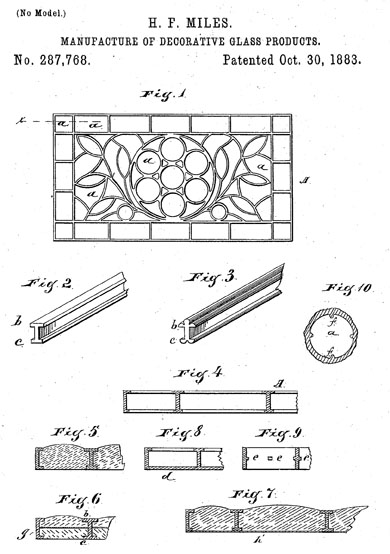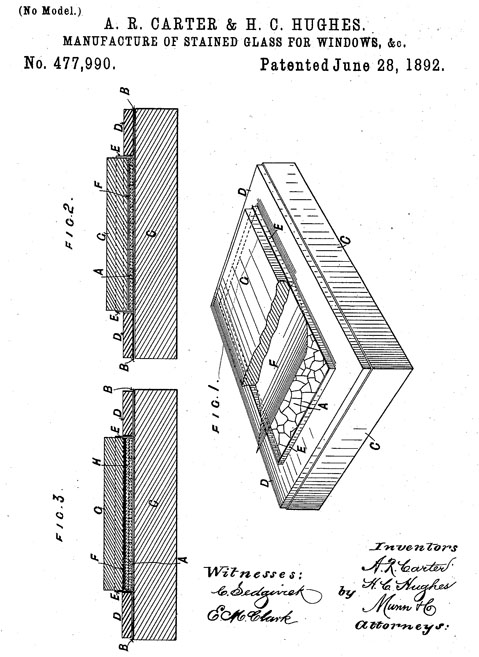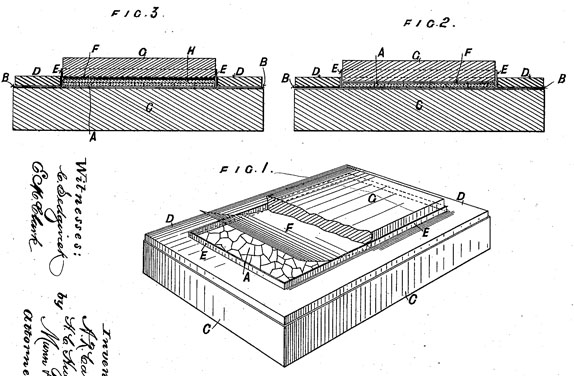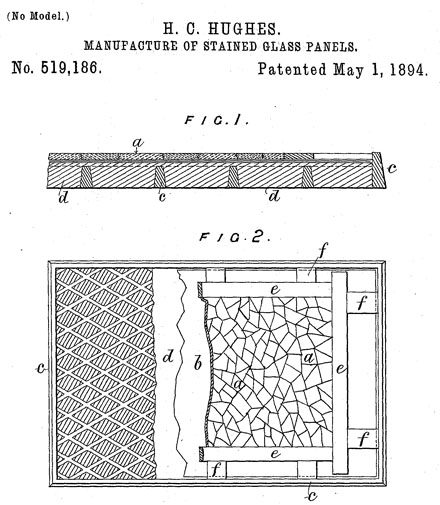December 02, 2009
Google Patents 3 - Pseudo Stained Glass or Proto-Fused Glass?
Call these "stained glass patent curiosities" - all of these either appear to look like stained glass or call themselves stained glass. Yet all of these patents seem to be for a "stained glass-like" appearance that is created with a form of melting glass into a metal matrix or fusing of the flat glass into a mold.
Manufacture of Decorative Glass Products,
Hollon F. Miles,
Chicago Illinois,
Patent number 287768, issued 1883
This appears to be at first glance a standard stained glass window, even in the cross sections. Only the bulging of the glass in figures 5,6,7 look unusual. In fact it is a method for melting glass into a pre-existing metal matrix. No details, like type of metal, etc. Hard to imagine this working under any circumstance, what with issues like contraction and expansion to deal with. I've never heard of or seen an example of any stained glass from that time constructed in this manner.

Manufacture of Stained Glass for Windows, etc.,
ARTHUR ROGER CARTER AND HENRY CLIFFORD HUGHES,
Patent number 477990, issued June 1892
The patent states that Arthur Roger Carter is a tobacco-manufacturer and Henry Clifford Hughes a stained glass manufacturer, both from London, England.
As far as I can tell from the arcane language, this is a straightforward fusing process, though done in a kind of mold made of platinum (used for its inoxidizabilty), mica, iron and fire-clay. There appears to be no attempt to simulate lead lines, though there is a mention of being able to fire the glass afterwards "with vitreous enamel color".

it's a little more legible sideways

Manufacture of Stained-Glass Panels,
Henry Clifford Hughes,
Patent number 519186, issued 1894
Specifically an elaboration of the last patent, as this is the same H.C. Hughes but without the tobacco-manufacturer. Again, it still seems to be for a kind of fusing process, where pieces of glass are placed on mica (instead of platinum) and kiln fired. This patent is a little clearer in its language, though not much. The pieces of glass are laid side by side, covered with a vitreous flux, and 'welded' together, including the idea of 'pressing on the glass joints with an iron tool' while at the 'welding point'. After cooling, the piece is then painted with 'vitrifiable enamel colors' and then covered with a piece of 'white glass' (I assume he means 'clear glass' in this case) and then 'welded' again to form the final stained glass panels.

Of course, you look at these patents and it makes you think - how is this easier, cheaper, or more effective than a traditionally made stained glass window.?
Then again, it is true that these patents could be seen as about 100 years ahead of their time, just waiting for the fusing/kiln-fired flat glass movement to happen.
Posted by Tom at December 2, 2009 06:06 PM